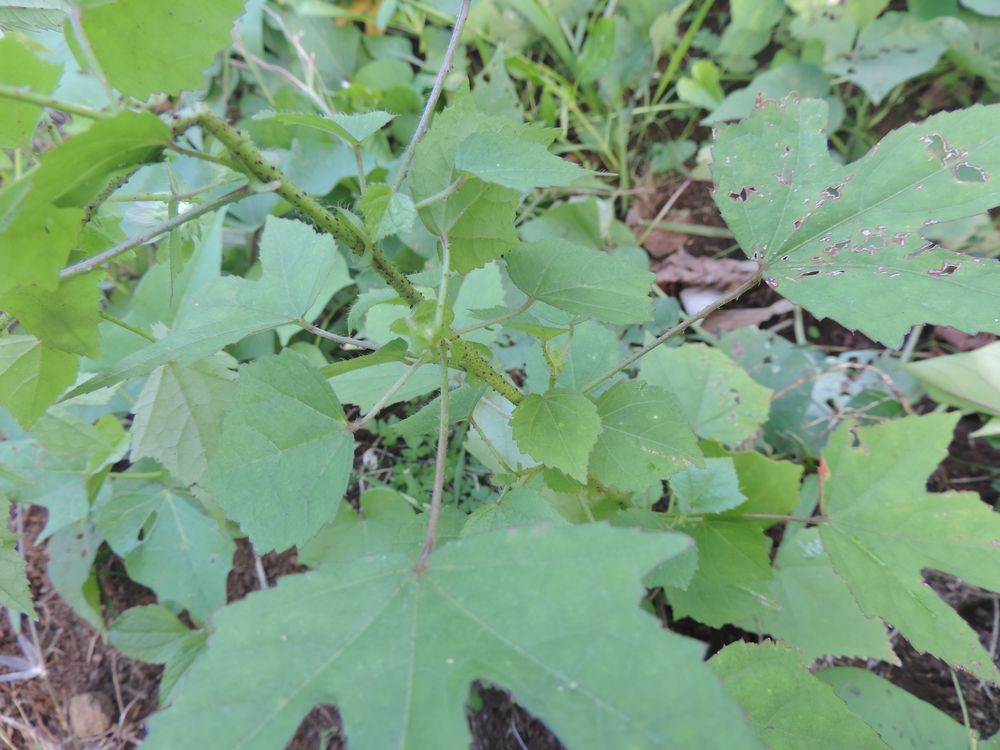Hibiscus surattensis

|
|
Hibiscus surattensis Common Names: Red-veined Sorrel, Bush Sorrel, Wild
Sour, Prickly Hibiscus Scientific
Classification Kingdom: Plantae Clade: Tracheophytes Clade: Angiosperms Clade: Eudicots Clade: Rosids Order: Malvales Family: Malvaceae Genus: Hibiscus Species: H. surattensis Synonyms: Abelmoschus aculeatus Walp., Furcaria surattensis (L.) Kostel., Hibiscus aculeatus G.Don, Hibiscus appendiculatus Stokes, Hibiscus bifurcatus Blanco, Hibiscus hypoglossus E.Mey. ex Harv., Hibiscus involucratus Salisb., Hibiscus surattensis
var. genuinus Hochr., Hibiscus surattensis
var. villosus Hochr., Hibiscus trinitarius Noronha Morphological Description Hibiscus surattensis is an erect, much-branched shrub or subshrub, typically
growing 1–3 m tall, occasionally reaching 4 m in moist conditions. Its key
morphological features include: · Stem: Cylindrical, densely covered with stiff, spreading stellate
hairs and prickly bristles, green to reddish, often woody at the base. · Leaves: Alternate, deeply 3- to 5-lobed (sometimes palmate), 5–15 cm
long, 4–12 cm wide, with serrated margins, covered in stiff hairs; petioles
2–10 cm long, bristly. · Flowers: Solitary, axillary, 5–8 cm in diameter, bright yellow with a
dark red or purple center; epicalyx with 8–12 lanceolate lobes; calyx with five
hairy sepals; petals five, obovate. · Fruit: Ovoid capsule, 1–2 cm long, pubescent, containing 15–25 seeds;
seeds brown, 3–4 mm, with minute warts. The prickly hairs and
lobed leaves are characteristic of this species within the Malvaceae family
(Hutchinson & Dalziel, 1958). Distribution and Habitat Hibiscus surattensis is native to tropical Asia and has naturalized widely,
occurring in: · Asia: India, Malaysia, Philippines, Thailand, Indonesia (annual
rainfall 1,000–2,500 mm). · Africa: Nigeria, Senegal, Ghana, Madagascar (introduced). · Oceania: Australia, Pacific Islands. It thrives in open,
sunny habitats—roadsides, grasslands, wastelands, and coastal dunes—preferring
well-drained, sandy soils (pH 5.5–7.0) and tolerating moderate salinity
(Burkill, 1997). Ethnopharmacology Hibiscus surattensis, also known as wild sour or bush sorrel, is a
medicinal plant traditionally used in various parts of Africa and Asia for its
anti-inflammatory, antioxidant, antimicrobial, and analgesic properties. The
leaves, flowers, and roots are commonly used in decoctions or infusions to
treat fevers, coughs, menstrual pain, stomach disorders, and skin infections.
It is also used as a diuretic, to promote wound healing, and to manage
hypertension and malaria in traditional systems. The plant is rich in
flavonoids, phenolic compounds, saponins, and tannins, which contribute to its
medicinal value. Scientific studies have supported some of these traditional
uses, particularly its antioxidant and antimicrobial activities, though more
research is needed to fully understand its pharmacological potential and
therapeutic applications. · Anti-inflammatory/Analgesic: Crushed leaves treat swelling and pain in
Nigeria. · Wound Healing: Leaf poultices heal cuts in the Philippines. · Digestive Aid: Leaf decoctions relieve dyspepsia in India. Rahmatullah et
al. (2010) noted its use for stomach issues, with mild laxative effects
attributed to mucilage. · Respiratory Relief: Leaf infusions treat cough in Senegal.
Burkill (1997) documents its use, with preliminary antimicrobial activity
against Streptococcus pneumoniae. · Antipyretic: Whole plant decoctions reduce fever in Malaysia. Wiart
(2006) supports its traditional use, though specific compounds remain
unidentified. ⚠ Toxicity Profile: No specific toxicity studies exist for H. surattensis. Related Hibiscus species (e.g., H. sabdariffa) contain trace pyrrolizidine alkaloids,
potentially hepatotoxic at high doses (>1,000 mg/kg in rats). The prickly
hairs may cause skin irritation (Herrera-Arellano et al., 2007). Additional Uses · Culinary: Young leaves and calyces, with a sour taste, are used as a
vegetable or souring agent in soups and stews in West Africa and Southeast Asia
(Burkill, 1997). · Ecological: Attracts butterflies and bees, enhancing pollination in
disturbed ecosystems (Verdcourt, 2001). · Cultural: Leaves used in traditional dyes in India (Rahmatullah et
al., 2010). References
External Links More Pictures |
|
| Compounds of Hibiscus surattensis | |
| References |